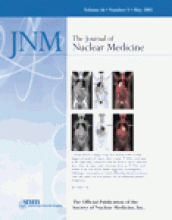TO THE EDITOR:
Mawlawi et al. (1) present an excellent study documenting the performance of the new Discovery PET/CT camera (General Electric Medical Systems). However, as a designer of PET cameras, I am perplexed as to why the resolution of this new camera is so poor.
The Discovery PET camera uses design concepts similar to those pioneered by Mullani et al. in 1984 for the Posicam PET camera (Positron Corp.) (2) but, to increase its sensitivity, has a smaller detector ring diameter and shorter septa and uses more of the cross-coincidences between adjacent slices. The detector size in the Discovery, at 6.3 mm, is significantly smaller than the 8.5-mm detector in the Posicam. Therefore, the resolution should be better for the Discovery than for the Posicam. However, the resolution of the Discovery, at 6.09 mm in full width at half maximum, is slightly lower than the published resolution (5.8 mm in full width at half maximum) of the Posicam.
Perhaps the authors or the designers of the Discovery PET camera would like to explain to the readers why the resolution of their camera is lower than for a similar camera using larger crystals.
REPLY:
My coauthors and I appreciate the observation of Dr. Mullani regarding the measured resolution of the Discovery ST PET/CT scanner (General Electric Medical Systems) that was presented in our article (1).
The resolution of a PET scanner depends on several factors, including the detector element size and ring diameter. It has also been shown that detector decoding, such as that used in block detector designs, can affect the system resolution (2). For scanners that are designed with 1 detector per photomultiplier tube, the scanner resolution is approximately half the detector size. On the other hand, scanners with a block detector design have resolutions that are roughly equal to the individual crystal size in the block (1). In this regard, stationary ring cameras such as the Discovery ST, which has a block detector design, will have a transaxial image resolution similar to its detector size of 6.3 mm. Transaxial resolution measurements have been published for several scanners from several different manufacturers (1,3–8), including the Discovery ST measurements that were recently published in The Journal of Nuclear Medicine (1). Each of these scanners uses block detectors, except for the Allegro (Philips Medical Systems), which uses a modular detector design with many properties of a block detector. In each case the resolution is approximately equal to the crystal size.
PET systems using different detector designs, such as that in the Posicam 6.5 (Positron Corp.) (9), may achieve resolution results different from those achieved by a block detector with a comparable detector size. Nonetheless, the resolution of the Discovery ST is not “poor” but is consistent with the expected results for its type of detector design.







